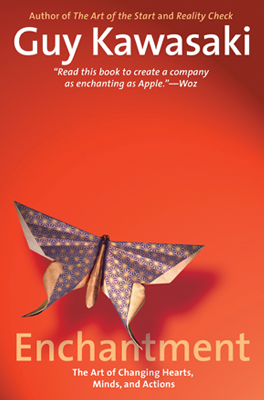Enchantment: The Art of Changing Hearts, Minds, and Actions

 Enchantment: The Art of Changing Hearts, Minds, and Actions
Enchantment: The Art of Changing Hearts, Minds, and Actions- Author: Guy Kawasaki
- Publisher: Portfolio/Penguin
- Publication: 2011 (March 3rd)
One part Dale Carnegie, one part Robert Cialdini, and one part Guy Kawasaki‘s best bits – Enchantment is the new Amazon business bestseller on how to enchant your customers by delivering delight, and in doing so creating affinity, commitment and loyalty.
To enchant is to do more than persuade, it is to delight, to seduce, and to inspire. To persuade is rational and cerebral, to enchant is emotional and experiential – and in a world of information-overload and product clutter, it is the emotional and experiential that cuts through. When you enchant, you create a smile – and that smile becomes associated with who you are, what you do and why you do it. That smile is brand equity of the most valuable kind.
Enchantment is something of a brain dump from Guy Kawasaki, the inspiring VC and former Apple marketer responsible for creating passionate user-advocates for the Macintosh brand; it’s neither structured nor systematic, and offers little in the way of synthesis in how to deliver that elusive customer smile. But what it does do is provide a useful curated list of insights from social psychology and business practice to help make customer happiness your business model. Here’s the speed summary in 10 points
1. The first step of enchantment is to see the world from the customer’s perspective – it’s business 101, but what exactly do your customers want, and if they want what you have, can they change and is it worth their effort to change?
2. To enchant customers and make them smile you need to be likeable, and that means genuinely respecting and admiring your customers. Your customers should make you smile; as the Chinese proverb goes, if you don’t like smiling, don’t open a shop.
3. To enchant customers, be trustworthy – that is show yourself to be knowledgeable and competent. Trust is one of the five key obstacles every sale faces – no need, no money, no hurry, no desire, no trust. Take a leaf from Zappos’ book – help customers trust you with actions rather than words (money back guarantee – free shipping in both directions)
4. To enchant customers, you need to engineer or reengineer your product or service to enchant. An enchanting product or service is DICEE
- Deep – has multiple layers of value
- Intelligent – solves problems in smart ways
- Complete – offer a turnkey expereince
- Empowering – helps people do what they do better
- Elegant – works with people, harnesses what they already think and do
5. To enchant customers, keep it brief – respect people’s time and attention. Few people have ever experienced a pitch or a presentation that is too short.
- If it’s a presentation, stick to the 10:20:30 rule (10 slides max, 20 mins max, 30 point font minimum)
- If it’s an email, limit it to six sentences (or adopt the apocryphal Microsoft policy, if it doesn’t fit in the subject line, it’s too long)
- If it’s a video clip, keep it to 60 seconds
- If it’s a report or business plan, 20 pages max
6. To enchant customers, allow them to trial your product or service in a way that is Easy, Immediate, Inexpensive, Concrete (Results), Reversible (Risk-Free) – and if you are in the launch phase, implement a mass product seeding campaign designed to delight and activate advocacy
7. To enchant customers, keep them enchanted. Enchantment that endures is when your customers internalize your brand, your product and your values, and make them their own. The customer journey begins with conformity (complying with a request to purchase, evolves through ‘identification’ (it’s a brand/company for me) and matures in internalization (it’s my brand company). Enduring enchantment requires paying it forward; surprising and delighting your customers by giving – rather than taking.
8. To enchant customers, remove the blocks to enchantment – Inertia, Hesitation to reduce options, fear of making a mistake, lack of role models, a cause that doesn’t connect. Use social proof (the power of example, lists and ubiquity to show you’re a good choice), scarcity (that you offer a scarce (therefore, valuable resource), stories (customer stories, and inside stories (behind the scenes) not stats), and superiority (show what you can do, that your competitors can’t)
9. To enchant customers, use media intelligently
- For ‘push media’ (bringing your story to people) email, Twitter, presentations), make it sensorial – one part text to two parts images, sound and video, make it short, and make it a story. Personalise the introduction, and ensure that it’s useful, even if they don’t buy
- For ‘pull media’ (bringing people to your story -websites, blogs, Facbook, YouTube), make it fast, make it free (no sign-up roadblocks, fan-gatign) and Flash-free. And offer content that has ‘intrinsic value’
- Inspirational Value
- Entertainment Value
- Enlightenment Value
- Educational Value
10. To enchant your customers, know that enchantment begins at home. Begin by enchanting your employees and your boss
- To enchant employees – offer them MAP – mastery, autonomy and purpose – not just a salary + bonus.
- To enchant your boss – re-prioritise your efforts to make them successful; drop everything and do what they ask – make them look good




